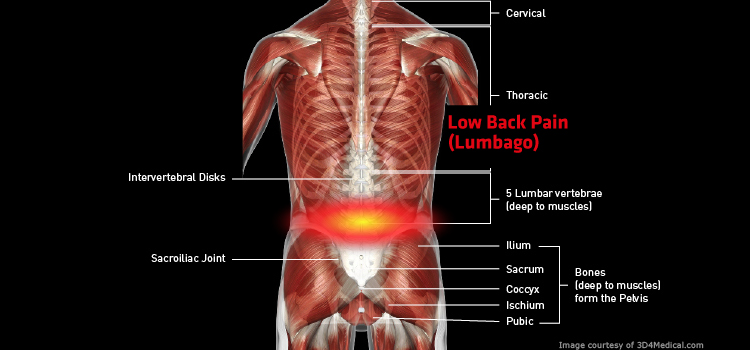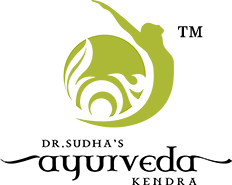
Low Back Pain
Low back pain has become the most common reason to visit a doctor. If you suffer from low back ache, then you are one among the 80% of the total adults in the world having the similar issue. Depending on the severity, nature of the cause or underlying disease the recovery can take a week up to months.
The incidence of low back ache has tremendously increased in past decade and the main reason for that will be our ignorance and neglect towards right posture, adequate amount of nutrients, vitamins and minerals in our diet, unhealthy food habits, heavy weight lifting or other similar activities. Both men and women are equally affected by low back pain and it can affect all age group form teenage to old age people. According to the intensity and duration of the pain, low back ache can be classified as acute, subacute and chronic. Acute low back pain: Last a few days to few weeks. it tends to resolve on its own or may even require very little care and rest.
Subacute low back pain: It is quite severe one and needs medical attention. It can last between 4 to 12 weeks.
Chronic back pain: persist for 12 weeks or longer. Even after treating the acute and subacute cases, the pain can reoccur with all the symptoms in one year. The pain may be relieved after the treatment in some cases, but in other cases the pain persists despite all treatments done. A chronic back pain in such cases may be due to some other underlying diseases which is affecting other systemic organs. The causes of low back pain can be broadly classified into
Musculoskeletal:
-
Mechanical causes such as muscle strain, muscle spasm due to injury, trauma, weight lifting, accidents etc.
-
Fracture to the bones comprising lumbar spine and pelvic girdle.
-
Slip disc, spinal stenosis, nerve root compression which is caused due to sudden jerk, blow or injury, weak lumbosacral, pelvic bones and muscle, tendons etc.
-
Degenerative diseases such as osteoarthritis spondylosis, osteoporosis etc.
Inflammatory:
-
Arthritis affecting the lumbar spine and pelvic girdle, ankylosing spondylitis, lumbar spondylitis.
Malignancy:
-
Cancer affecting bone and bone marrow, metastasis from other organs such as lungs, breast, thyroid, uterus, prostate, retrim, intestine etc.,
-
Tumor or cysts formed in the lumbar and pelvic region compressing the nerves and blood vessels supplying them.
Infections:
-
Osteomyelitis, TB, pelvic inflammatory disease.
Investigations
X-rays are helpful in case of spondylosis, spondylolisthesis, degenerative arthritis, congenital anomalies, fractures, ankylosing spondylitis, loss of normal curvature of vertebral column.
MRI can be used to get a detailed view of the bony as well as soft tissue structure, disc prolapse, stenosis etc. can be understood by this. CT can also be used to view the soft tissue structure in case MRI is contraindicated. Ultrasonography of abdomen and pelvic can reveal abnormalities related to organs. Kidney stones, uterine fibroid, polyp, gall bladder stone etc. can be confirmed through this. Lab test such as CBC, ESR, RA factor, uric acid, calcium, Vit D3, B12, HLA-B27, ACCP, CRP, TFT, LFT, KFT ETC should be done to rule out systemic diseases.
Symptoms:
Acute low back pain starts with pain which is usually confined to the lumbosacral region with restricted or painful movements. As the problem progresses, the intensity of the pain can also vary up to which the pain becomes unbearable to the patient.
Depending upon the degree of the disc prolapse and nerve root compression, the pain can radiate to one or both legs with neurological symptoms such as paresthesia, tingling, numbness, altered sensation etc. Patient can even experience loss of sensory and motor function of lower limb with loss of sensation to urinate and defecate.
Backpain explained in Ayurveda
Backpain can be called as katigraha/ katisoola/gridrasi depending on the nature and severity of the disease. It comes under vata roga.
The causative factors can be due to faulty diet such as over intake of hot, bitter, astringent, dry, cold foods, over intake of dry meat, dry vegetables, fasting, spicy food etc.
Faulty lifestyle changes such as over exercise, heavy weight lifting, improper posture while sitting and sleeping, not sleeping at night, holding natural urges to pass urine, feaces, flatulence etc., exposure to dry, cold, wind for a long time, excess indulgence in sex, injury or trauma to the body can also cause vata dosha vitiation in the body.
Psychological factors that causes vata vitiation are indulging in excessive thinking, grief, anger and fear.
The vata vitiated by these factors take Ashraya (abode) in kati/ prishta region (lumbar and pelvic region) producing soola(pain) in that region.
This vitiated vata dosha can cause degenerative changes in the structures present in that region such as vertebral bodies, intervertebral disc, tendons, ligaments, muscles etc. The shleshaka kapha present in the intervertebral disc spaces gets dried up due to the vitiated vata dosha, leading to hampered functioning of the joints preventing the normal movement of the lumbar and pelvic region.
If the vitiation is due to an external cause such as a trauma or injury, then there will be displacement in the normal positioning of the structures like intervertebral disc, vertebral bodies etc. causing tension to the nerves passing through it. This can manifest as radiating pain to the legs (either one or both can be affected). In that case it’s called “ghridrasi” or Sciatica.
Initially, the patient will be having pain only in the low back region, but as the disease progresses the pain can spread to upper back, buttocks, thighs etc. limiting the range of movement. If the problem is unattended or not managed properly, the pain can radiate to the legs causing neurological problems such as altered sensations, tingling, numbness. Heaviness, burning and even sensory loss and muscle wasting.
Management:
-
Arrest the process of degeneration and help in regeneration of damaged tissues.
-
Repositioning the prolapsed disc and releasing the nerve root compression.
-
Strengthen the bones, muscles and other supportive structures of lumbo-sacral and pelvic region to prevent the reoccurrence of the conditions again.
-
Both internal medicines and external therapies should be simultaneously used for the effective management of low back ache.
Internal medicines will help in healing of the damaged tissue, arrest the further deterioration and provide nourishment to the structures.
External treatments such as Panchkarma procedures, Pizhichill, Kativasti, prishtavasti etc should be administrated. Ayurveda considers vasti (medicated enema) as Ardha- chikitsa (half of the treatments put together). Vasti controls the vitiated vata dosha which is situated in the pakwasaya (lumbo-sacral and pelvic region).
Oleation should be given externally in the form of massages. Abhyangam, Pizhichil are the two effective ways for providing oleation to the body. Doing this regularly for a definite period of time will stop the degenerative process and brings lubrication and strength to the joints.
The vitiated vata dosha activity decreases thus promoting the shleshaka kapha in between the joints.
The intervertebral disc becomes regenerated, disc space is increased, disc will be repositioned back to normal thus finally relieving the nerve root compression. Lubrication to the joints will improve the range of movement.
Treatment such as Pathrapinda sweam (Elakizhi), Choornapinda Swedam (Podikizhi) helps in releasing the local inflammation and swelling, thus reducing the pain. Shashtika pinda swedam (Njavarakizhi) helps in strengthening the muscles, bones and supporting structures, improves the functioning of the nerves and muscles.
Prishtavasti/ kativasti is a peculiar treatment advised in this condition. A dam is built with dough in the affected area and warm oil is retained in it for specific period of time. The oil should be at a height of 2 inches from the body and should be constantly warm. This treatment can nourish the intervertebral disc, lubricate and reposition it to its normal state. This will relieve the tension between the nerve roots.
General recommendation for patients who have recovered from low back pain.
-
Stretching of activities that place additional stain on the back are discouraged.
-
Forward bending and lifting heavy weight should not be done.
-
Adequate low back support should be provided while sitting continuously in office or while driving. Chairs of appropriate height and beds which are comfortable should be used.
-
Restrain from all physical activities which will ultimately lead to tension in the back region such as playing sport, sex etc.
-
Remember the factors that causes the vata dosha to vitiate and restrain from doing it again.
-
Up to 3 months, patients should be very conscious about these restrictions.
-
Take internal medicines regularly and apply oil on the affected part daily for about minimum of 3 months after the treatments.
-
If you wishes to be healthy and active, apply medicated oil regularly on your body and leave it for some time before taking bath every day.
Yoga and exercises
After complete recovery and rest, you can start practicing simple yoga postures which will strengthen the lumbosacral and pelvic region. Start from simple stretching exercise before practicing postures. It is very important to keep in mind that one should not be practicing and yoga or physical exercise right after recovering form back pain.

